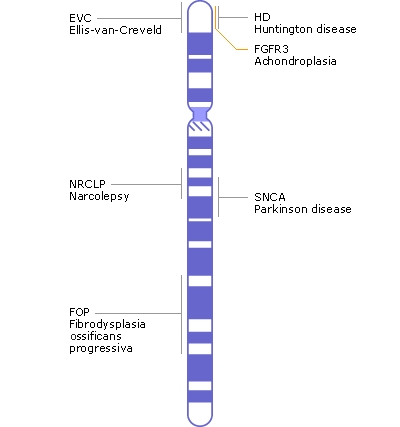Chromosome 4 is the fourth largest of the 23 pairs of chromosomes in humans. Chromosome 4 is made up of over 186 million base pairs, the building blocks of DNA which are tightly packed and super coiled to from the DNA helix. Chromosome 4 represents around 6% to 6.5% of the DNA in the human genome.

Genetic research is focused on identifying the genes on our chromosomes and estimates suggest that chromosome 4 contains around 1000 to 1100 genes. Gene mutations on chromosome 4 have been linked to genetic disorders and identified in several types of cancer.
Examples of conditions associated with gene mutations on chromosome 4 include neurological and neurodegenerative disorders such as Parkinson's disease, Huntington's disease and narcolepsy. Chromosome 4 also plays a role in other disorders such as the connective tissue disorder fibrodysplasia ossificans progressiva and a form of dwarfism called achondroplasia.
Some of the genes that are located on chromosome 4 include:
- ANK2 (codes for neuronal ankyrin 2)
- CRMP1 (codes for Collapsin response mediator protein 1)
- CXCL1 to 13 (codes for the chemokines, Platelet factor-4, interleukin 8 etc.)
- EVC and EVC2 (mutations lead to Ellis van Creveld syndrome and Ellis van Creveld syndrome 2)
- FGFR3 (codes for fibroblast growth factor receptor 3 absence of which leads to achondroplasia, bladder cancer, dwarfism)
- FGFRL1 (codes for fibroblast growth factor receptor-like 1)
- Complement Factor I, HTT (codes for huntington protein)
- MMAA (codes for methylmalonic aciduria)
- PHOX2B (codes for homeodomain transcription factor)
- PKD2 (mutations of which leads to autosomal dominant polycystic kidney disease 2),
- QDPR (codes for quinoid dihydropteridine reductase)
- SNCA (codes for synuclein, alpha)
- UCHL1 (codes for ubiquitin carboxyl-terminal esterase L1)
- WFS1 (codes for Wolfram syndrome 1)
- FGF2 (codes for fibroblast growth factor 2)
- KDR (Kinase insert domain receptor) etc.
Sources
- www.nhmrc.gov.au/…/07_chromosomal_conditions.pdf
- www.nature.com/…/4.html
- http://www.ncbi.nlm.nih.gov/pmc/articles/PMC1049626/
Further Reading
- All Chromosome 4 Content
- Chromosome 4 Related Diseases
Last Updated: Feb 15, 2019

Written by
Dr. Ananya Mandal
Dr. Ananya Mandal is a doctor by profession, lecturer by vocation and a medical writer by passion. She specialized in Clinical Pharmacology after her bachelor's (MBBS). For her, health communication is not just writing complicated reviews for professionals but making medical knowledge understandable and available to the general public as well.
Source: Read Full Article